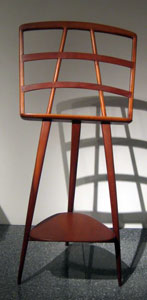Search Results - Esherick, Wharton
Wharton Esherick
 Wharton Esherick (July 15, 1887 – May 6, 1970) was an American artist and designer. An artistic polymath, he worked in a wide variety of art media including painting, printmaking, and sculpture. His design works range from architectural interiors to handheld, tactile objects like light pulls and chess pieces. Esherick is best known for his wood furniture, which synthesizes modernist sculptural form with functional craft. His influence was keenly felt within the genre of Postwar studio craft, where he has been called the “father of studio furniture” and the “dean of American craftsmen.” The sculptor and furniture designer Wendell Castle cited Esherick as a formative influence. Castle credited Esherick with demonstrating that "furniture could be a form of sculpture," the "inherent tree characteristics in the utilization of wood," and the "importance of the entire sculptural environment."
Wharton Esherick (July 15, 1887 – May 6, 1970) was an American artist and designer. An artistic polymath, he worked in a wide variety of art media including painting, printmaking, and sculpture. His design works range from architectural interiors to handheld, tactile objects like light pulls and chess pieces. Esherick is best known for his wood furniture, which synthesizes modernist sculptural form with functional craft. His influence was keenly felt within the genre of Postwar studio craft, where he has been called the “father of studio furniture” and the “dean of American craftsmen.” The sculptor and furniture designer Wendell Castle cited Esherick as a formative influence. Castle credited Esherick with demonstrating that "furniture could be a form of sculpture," the "inherent tree characteristics in the utilization of wood," and the "importance of the entire sculptural environment."The most comprehensive realization of Esherick's vision for a sculptural environment is his home and workplace, the Wharton Esherick Studio on Valley Forge Mountain in Malvern, Pennsylvania. The Studio is a total work of art, or Gesamtkunstwerk, in which hand crafted design elements large and small unite to form a totality. The building is preserved as the centerpiece of the Wharton Esherick Museum, which opened in 1972. It was designated a National Historic Landmark in 1993. Provided by Wikipedia